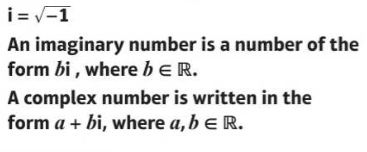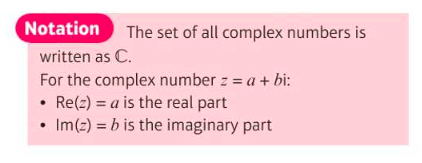Imaginary and Complex Numbers
Introduction
⇒ The quadratic equation ax2 + bx + c = 0 has solutions given by:

⇒ If the expression under the square root is negative there are no real solutions
⇒ You can find solutions to the equation in all cases by extending the number system to include √-1
⇒ Since there is no real number that squares to produce -1, the number √-1 is called an imaginary number and is represented using the letter i
⇒ Sums of real and imaginary numbers, for example 3 + 2i are known as complex numbers


Example

⇒ In a complex number, the real part and the imaginary part cannot be combined to form a single term
- Complex numbers can be added or subtracted by adding or subtracting their real parts and adding or subtracting their imaginary parts
- You can multiply a real number by a complex number by multiplying out the brackets in the usual way


⇒ Note: complex numbers are often represented by the letter z or w
Quadratic Equations
⇒ You can use complex numbers to find solutions to any quadratic equation with real coefficients
- If b2 - 4ac < 0 then the quadratic equation ax2 + bx + c = 0 has two distinct complex roots, neither of which are real


Extra
⇒ Also see our notes on: